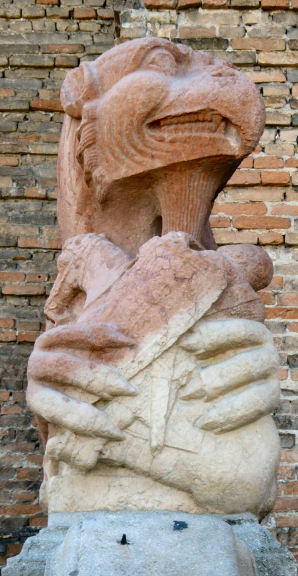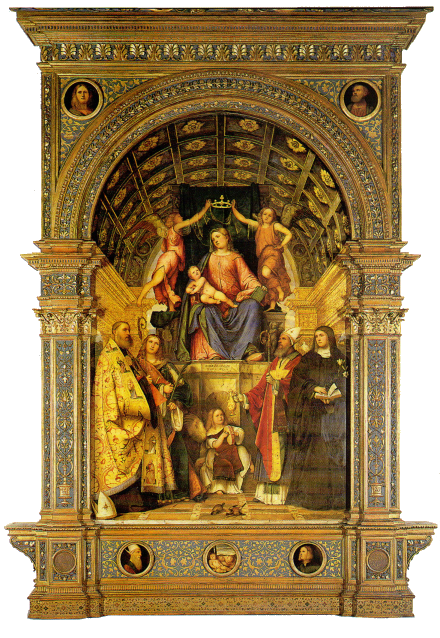|
|
|
History It is said that in 304 Giustina, the 16 year-old daughter of King Vitaliano of Padua, refused marriage to the pagan Roman Emperor Maximus and was martyred with a sword on Ponte Corvo, and that over her tomb here, in an Early Christian cemetery, a small Basilica was built in the early 5th century and enlarged around 520. She became the patron saint of Padua and popular in the Veneto. The church became part of a Benedictine abbey in the 8th century using funds, it is said, provided by the invading Lombard kings Liutprando and Ildebrando. More rebuilding from 1117, after the same earthquake that did for many of Padua's churches. After two more rebuildings came the church's current form, which dates from 1529-79 with Girolamo da Brescia, Andrea Moroni and Andrea da Valle as successive architects. This is said to be the 11th (or 9th) largest Christian church in the world.  The Benedictine monastery and church was suppressed by Napoleon in 1810,
and suffered much through its use from 1816 as a barracks by the Austrian
army,
but the church reopened and a monastery was re-established here in 1919.
This now houses a library
and book-restoration centre. The Benedictine monastery and church was suppressed by Napoleon in 1810,
and suffered much through its use from 1816 as a barracks by the Austrian
army,
but the church reopened and a monastery was re-established here in 1919.
This now houses a library
and book-restoration centre.The church Bare brick and huge - larger than the Santo, which seems to have inspired its form, especially the four large and four small domes. Two 14th-century Veronese rosso e grigio marble gryphons (see right) at each end of the entrance staircase, were taken from the protiro of the medieval church. Interior Big and renaissance, with very chunky pillars. Six deep flat-backed chapels in three bays down each side of the nave with three shallow cupolas over the nave corresponding with each bay. The first five chapels each side have matching marble altars with unspectacular 17th century altarpieces by the likes of Loth, Luca Giordano, Sebastiano Ricci, and a pair of Scuola del Veronese in the first facing pair. The fifth on the right is the best lit with Palma Giovane's Saint Benedict receives Saints Maurus and Placidus. There are also works by Bissoni and Balestra. Then there's a pair of longer apse-ended chapels with sculpture-topped altars. The huge transept has apse-shaped ends too with more modest altars. There's than another pair of apse-ended chapels with matching sculptural altars, then two more deep chapels flank the choir. All of these chapels are lacking in painted decoration. There are staircases down to a crypt either side of the stairs up to the choir. Over the high altar, far off at the end of the choir, is Veronese's crowded masterpiece The Martyrdom of Santa Giustina of 1574/5, which has the church in the left background. It features, according to Pignatti, 'a flight, nothing less than irritating, of too many angels.' The (roped-off) choir also has carved walnut choir stalls of deserved fame by Riccardo Taurigny from 1558/66, and the remains of the saint herself under the high altar. The chapel right of choir has a very agitated Pieta of 1689 by Filippo Parodi, who is said to have brought the style of his teacher Bernini to Padua and was responsible for the very baroque reliquary chapel in the Santo. The chapel to the left of the choir has a frescoed ceiling by Sebastiano Ricci, the only frescoing in the main church, with some nice trompe l'oeil effects. The left hand transept is the Chapel of Saint Luke with the saint's relics in a 14th-century marble Arca and an icon of the Virgin and Child, along with works on the walls by Balestra and Galvani. Through the right-hand transept, with its pair of huge canvases, one each by Bissoni and Balestra, behind the small altar, there is the suddenly very decorated Corridor of the Martyrs, named for the Martyr's bones found down a well here. It was built to link the church with the ancient chapel of Saint Prosdocimus after the old chapel was destroyed by an earthquake in 1117. Facing you before you turn left at the end is The Blessed Giacoma Discovers the Well of the Martyrs by Pietro Damini. Turning left you enter the corridor where access to the subterranean passages containing the relics, amongst them bits of Saints Luke and Matthew, is gained through a trap-door to the right. You then come to the Sacellum di Santa Maria e San Prosdocimo (see two photos below right) all that remains of the original basilica. Here, under the window, is the tomb of Saint Prosdocimus who was the first bishop of Padua in the 4th century, when the church that stood here was founded. Lost art  The Saint Luke Polyptych, the earliest surviving altarpiece by Andrea Mantegna, painted in 1453-55 for the chapel of Saint Luke (the left transept) here, is now in the Brera in Milan. Painted for the Benedictine abbot Mauro de'Folperti of Pavia, it's big and special, with two rows of saints in arched panels in traditional gothic style, and you can get up close and fully appreciate. It was looted from the abbot's private rooms by the French in 1797. The huge, impressive and very Venetian early-16th-century Virgin Enthroned with Saints Benedict, Justina, Prosdocimus and Scholastica (see right) by Girolamo da Romano (called Romanino) is now in the Eremitani Civic Museum. As is his panel depicting the Last Supper painted for the refectory here. Also there is the equally early-16th century Venetian-looking Virgin and Child Enthroned with Saints Benedict and Justina by Giampietro Silvio, and a Deposition by the same artist. The Martyrdom of Saint Justina of 1556 by Paolo Veronese, which hung here over the Abbot’s private altar in his study is now in the Eremitani Civic Museum. Also by Veronese is a Crucifixion, painted on paragone, a dark stone, now in the Eremitani Civic Museum. A large detached fresco panel of The Deposition, with roundels depicting saints, probably of 1515/20 by Girolamo Tessari (called Dal Santo) is in the Eremitani Civic Museum. The V&A in London has a Sarcophagus of Santa Giustina which seems to have been made for this church and is perhaps the one commissioned in 1476 but never used to contain the body of the saint.  Lost manuscripts Benedetto Bordon (c.1455-1530) was commissioned in 1523 to decorate an Evangeliary (Gospel Book) and an Epistles for the monastery here. These manuscripts are in the Chester Beatty Library in Dublin and the British Library respectively. An initial showing The Resurrection (MS Marlay 18i) cut from an Antiphoner (choir book) which is part of a multi-volume set still to be found in Santa Giustina, is now in the Fitzwilliam Museum in Cambridge. The Victoria & Albert museum in London has a manuscript cutting of an historiated initial M showing Santa Giustina disputing with Maximian (see left), from an antiphonary, signed by Girolamo da Cremona c.1461. Campanile The lower part is the original tower. By 1599 the church had grown such that the bells could not be heard, it is said, so the height was doubled. Buried here Elena Cornaro Piscopia, the celebrated scholar and the first woman to receive a university degree, was buried here in 1684. She eventually earned a philosophy doctorate. Her first choice of subject had been theology but Gregorio Cardinal Barbarigo, the Bishop of Padua, had forbidden this course as she was a woman. The church in art Prato della Valle, with Santa Giustina and the Monastery of the Benedictine Nuns is a painting of c.1756 by Canaletto, of which several versions exist, including a good one - and the only one that's signed - in the Museo Poldi Pezzoli in Milan. It shows the Prato della Valle before the landscaping and canal building - it's just a field. There are also some view drawings by Bernardo Bellotto, Canaletto's nephew, showing Santa Giustina, in the background mostly, but the is one in the MET called Santa Giustina and the Prato della Valle at Padua (see below) from c.1740/41
Opening times
|
|
|
|
|
||
|
|